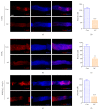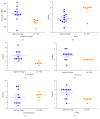Asparagus cochinchinensis Extract Alleviates Metal Ion-Induced Gut Injury in Drosophila: An In Silico Analysis of Potential Active Constituents
- PMID: 27123034
- PMCID: PMC4830720
- DOI: 10.1155/2016/7603746
Asparagus cochinchinensis Extract Alleviates Metal Ion-Induced Gut Injury in Drosophila: An In Silico Analysis of Potential Active Constituents
Abstract
Metal ions and sulfate are components of atmospheric pollutants that have diverse ways of entering the human body. We used Drosophila as a model to investigate the effect of Asparagus cochinchinensis (A. cochinchinensis) extracts on the gut and characterized gut homeostasis following the ingestion of metal ions (copper, zinc, and aluminum). In this study, we found that the aqueous A. cochinchinensis extract increased the survival rate, decreased epithelial cell death, and attenuated metal ion-induced gut morphological changes in flies following chronic exposure to metal ions. In addition, we screened out, by network pharmacology, six natural products (NPs) that could serve as putative active components of A. cochinchinensis that prevented gut injury. Altogether, the results of our study provide evidence that A. cochinchinensis might be an effective phytomedicine for the treatment of metal ion-induced gut injury.
Figures





Similar articles
-
Asparagus cochinchinensis: A review of its botany, traditional uses, phytochemistry, pharmacology, and applications.Front Pharmacol. 2022 Nov 30;13:1068858. doi: 10.3389/fphar.2022.1068858. eCollection 2022. Front Pharmacol. 2022. PMID: 36532772 Free PMC article. Review.
-
Asparagus cochinchinensis alleviates disturbances of lipid metabolism and gut microbiota in high-fat diet-induced obesity mice.Front Pharmacol. 2022 Oct 12;13:1015005. doi: 10.3389/fphar.2022.1015005. eCollection 2022. Front Pharmacol. 2022. PMID: 36313282 Free PMC article.
-
Aqueous root extract of Asparagus cochinchinensis (Lour.) Merr. Has antioxidant activity in D-galactose-induced aging mice.BMC Complement Altern Med. 2017 Sep 25;17(1):469. doi: 10.1186/s12906-017-1975-x. BMC Complement Altern Med. 2017. PMID: 28946917 Free PMC article.
-
The antioxidant effect of Asparagus cochinchinensis (Lour.) Merr. shoot in D-galactose induced mice aging model and in vitro.J Chin Med Assoc. 2016 Apr;79(4):205-11. doi: 10.1016/j.jcma.2015.06.023. Epub 2016 Feb 28. J Chin Med Assoc. 2016. PMID: 26935854
-
Regulatory effects of transition metals supplementation/deficiency on the gut microbiota.Appl Microbiol Biotechnol. 2021 Feb;105(3):1007-1015. doi: 10.1007/s00253-021-11096-2. Epub 2021 Jan 15. Appl Microbiol Biotechnol. 2021. PMID: 33449129 Review.
Cited by
-
Asparagus cochinchinensis: A review of its botany, traditional uses, phytochemistry, pharmacology, and applications.Front Pharmacol. 2022 Nov 30;13:1068858. doi: 10.3389/fphar.2022.1068858. eCollection 2022. Front Pharmacol. 2022. PMID: 36532772 Free PMC article. Review.
-
Anti-Inflammatory Response and Muscarinic Cholinergic Regulation during the Laxative Effect of Asparagus cochinchinensis in Loperamide-Induced Constipation of SD Rats.Int J Mol Sci. 2019 Feb 21;20(4):946. doi: 10.3390/ijms20040946. Int J Mol Sci. 2019. PMID: 30795644 Free PMC article.
-
Development of microsatellite markers based on expressed sequence tags in Asparagus cochinchinensis (Asparagaceae).Appl Plant Sci. 2017 Apr 18;5(4):apps.1700021. doi: 10.3732/apps.1700021. eCollection 2017 Apr. Appl Plant Sci. 2017. PMID: 28439480 Free PMC article.
References
-
- Matus K., Nam K.-M., Selin N. E., Lamsal L. N., Reilly J. M., Paltsev S. Health damages from air pollution in China. Global Environmental Change. 2012;22(1):55–66. doi: 10.1016/j.gloenvcha.2011.08.006. - DOI
-
- Zhefeng L., Qiongjie C., Yuqi F., et al. Research on effects of cadmium induced intestinal epithelial cell injury and regulation on intestinal stem cells regeneration and differentiation in Drosophila mid-gut. Chinese Journal of Cell Biology. 2013;35(5):602–608.
LinkOut - more resources
Full Text Sources
Other Literature Sources
Molecular Biology Databases

